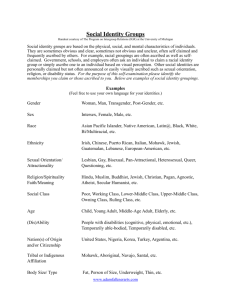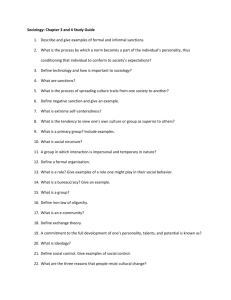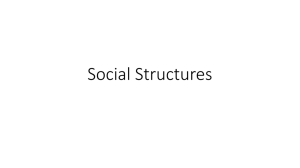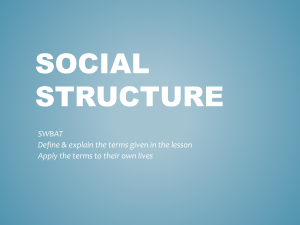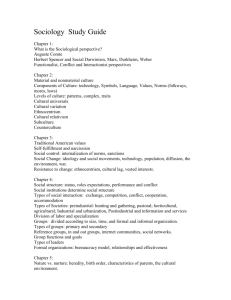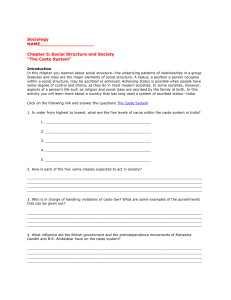Social Interaction and Social Structure
advertisement
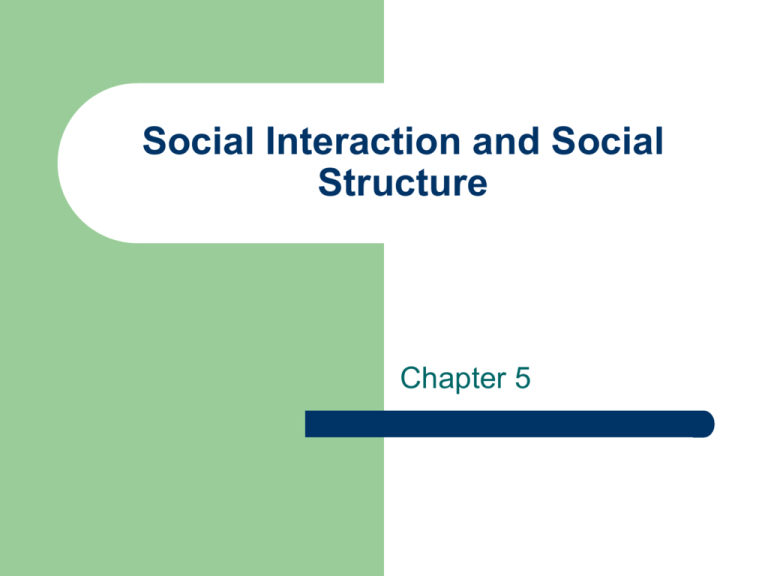
Social Interaction and Social Structure Chapter 5 Mock Prison Experiment Phillip Zimbardo at Stanford University 70 Male students were paid to give up vacation time to simulate a prison in the basement corridor of a school building arbitrarily designated as prisoners or guards (flip of a coin) guards acted “guardlike”. Some tough but fair 1/3rd became cruel and abusive <Zimbardo’s Mock Prison Slide Show and Discussion of Social Interaction and Reality Herbert Blumer-response to someone’s behavior is based on the meaning we attach to his or her actions meanings typically reflect the norms of the dominant culture and our socialization experiences Interactionalists-meanings attached are shaped by interactions <reality is constructed by our interactions Defining and Reconstructing Reality Regard tattoos-few short years ago- “weird, kooky” associated with fringe counterculture-punk rockers, bike gangs, skinheads increased social interaction with people with tattoos has brought about a different view <Tattooed Brett Michaels of Poison Negotiated Order Social reality can be negotiated as changes occur in social interactions negotiation refers to attempt to reach an agreement with others concerning some objective does not involve coercion through negotiation as a form of social interaction- society creates social structure Negotiated Order-social structure that derives its existence from social interaction through which people define and redefine its character Status Status-any of the full range of socially defined positions within a large group or society Ascribed Status-”assigned” by a society without regard for talent Conflict Theorists are especially interested in these Achieved Status- comes largely through our own efforts our achieved status is heavily influenced by our ascribed status Master Status-a status that dominates others and thereby determines a person’s position within society <Malcolm X. was told by an English Teacher: being a lawyer was “no realistic goal for a nigger” and encouraged him to be a carpenter Status Exercise Put in the middle of the circle ‘ME’ surround yourself with circles filling each with a status on top put- ascribed statuses-make it a certain design on bottom -achieved statuses-make it a certain design star -the master status Social Roles and Role Conflict Social Roles-Set of expectations for people who occupy a given status view someone as only a “police officer”, difficult to view as a “friend” Role Conflict-incompatible expectations arise from two or more social positions held by the same person women promoted to supervisor on an assembly line individuals move into occupations that are common among through ascribed status Role Strain and Exit Role Strain-difficulty of occupying two social positions simultaneously Zimbardo-as professor at the head of an experiment and as professor looking out for the welfare of his students Julius and Ethel Rosenberg-spies?, scientists Role Exit-adjustments made when leaving a role-eg. Ex-convict, quitting a job, divorce four stages of role exit 1. Doubt 2. Search for alternatives 3. Action stage or departure 4. Creation of a new identity Groups Groups-Any number of people with similar norms, values and expectations who interact with one another Women’s basketball team, hospital’s business office, symphony orchestra entire staff of a hospital is not staff members rarely interact vital part in social structure also now- those who interact electronically these transmission allows for impression management-alter one’s ego Social Institutions Social Institutions-organized patterns of beliefs and behaviors centered on basic social needs five Social Institutions (in no specific order) 1. Family 2. Government 3. Education 4. Business 5. Religion Perspectives on Social Institutions Functionalist Perspective(David Aberle (1950), Raymond Mack and Calvin Bradford (1979) 5 functional prerequisites must accomplish to stay alive 1. Replacing personnel-die, leave or become incapacitated <Shakers-came in 1774celibacy-must replace personnel through recruitment (6000 in 1840’s-7 in 1999) Functionalist Perspective of Social Institutions 2. Teaching New Recruitsgroup must encourage the recruits to learn and accept its values and customs learning can take place formally in schools (manifest function) or informally through interaction and negotiation in peer groups (latent function) 3. Producing and distributing Goods and Servicessociety must provide goods and services for its members the group must provide for most members or the members will become discontent and grow into disorder Functionalist Perspective of Social Institutions <4. Preserving ordernative people of Tasmania are now extinct-1800’s destroyed by the hunting parties of European conquerors-looked on as half human must protect themselves from attack as well as preserve order 5. Providing and maintaining a sense of purposepeople must feel motivated to continue as a member of that society to fulfill the other four requirements Conflict Theorist Perspective on Social Institutions Do not agree with the functionalists object to the idea that the outcome is efficient and desirable present order is not an accident maintains the privileges of certain powerful groups and individuals, contributing to the powerlessness of those without power social institutions are inherently conservative Conflict Theorists Perspective on Social Institutions Functionalist-social change could be dysfunctional why should we preserve unfair and discriminatory social structures? Social Institutions work in Gender and racist environments Matrix of Domination-Patricia Hill Collins (1971)-interlocking models of oppression-unless activists or policymakers intervene-those in less advantaged groups will remain in those groups Interactionalist Perspective of Social Institutions Emphasize that our social behavior is conditioned by the role and statuses that we accept, the groups which we belong, and the institutions in which we function “judge”-in relation to attorney, defendant, plaintiff, witness judicial system derives its significance due to the roles people carry out in social interactions Gemeinschaft and Gessellschaft Ferdinand Tonnies(1855-1936)rise of industrial city marked the end of the ideal type close-knit community-Gemeinschaft brought about the impersonal mass society-Gessellschaft <Characteristics of both Sociocultural Evolution Gerhard Lenski-change according to the dominant pattern rather than opposite forces as Tonnies had seen level of technology is critical to the way it is organized <Technology-information about the ways in which material resources of the environment may be used to satisfy human needs and desires. Preindustrial Society 1. Hunters and Gatherers-rely on food and fiber readily available technology is minimal, organized in groups and constantly searching for foodlittle division of labor small widely dispersed groups, each group is related-kinship ties rule the groups last group has virtually disappeared by the close of the 20th century Preindustrial Society 2. Horticultural Society-plant seeds and crops rather than subsist merely on available food much less nomadic production of tools and household objects technology is still limiteddigging sticks or hoes are the furthest reaches of technology 3. Agrarian Society-production of food technology allows for increased production-Plow Preindustrial Society Still relies on physical power of humans and animals social structure has more defined roles than in Horticultural society individual concentrate on specialized tasks-ie. Blacksmith social institutions become more elaborate-property rights create artifacts Industrial Society Industrial revolution-in England between 1760-1830 scientific revolution focused on the nonanimal(mechanical) sources of power to labor tasks people left the homesteads and started to work in centrally located factories specialization of task social consequences-families and communities could not function as self-sufficient units individuals, villages and regions exchanged goods and services and interdependent Industrial Society Family loses its position as the power source and authority specialization knowledge leads to more formalized education, education becomes distinct from the family Postindustrial and Modern Society Postindustrial-a society whose economic system is engaged primarily in the processing and control of information main output is services not manufactured goods Postmodern-technologically sophisticated society that is preoccupied by consumer goods and media images global perspective-note the ways a nation’s culture crosses its borders

